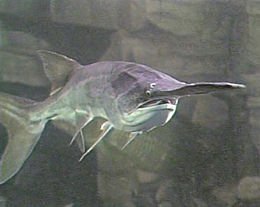China has acted too little, too late, as news of one of the first animal extinctions is announced for 2020. The Chinese Paddlefish (relative of Swordfish) is a freshwater species that enjoyed living in the 3,200 km stretch of the Yangtze River for 150 million years, but were down to only 9 known individuals in 2009, and none have been seen anywhere in the River for approximately 8-10 years, and there are none in captivity.
Only last week, the Chinese Ministry of Agriculture and Rural Affairs, announced a 10-year ban on fishing at 300 conservation areas along the river, Vice Minister Yu Kangzhen told the China Daily. I'm not sure how well that will go, as the human population living in the environs of the river is mind-blowing.
The largest known ever recorded Chinese Paddlefish was 23 feet long, and weighed in at several thousand pounds. These fish were known as the water tiger, or panda of the Yangtze. They were a charismatic megafauna species found in a freshwater ecosystem. The extinction is thought due to habitat fragmentation and overfishing. They travelled in schools near the surface, and were easily netted. The species reproduced later in life (as it took time to grow to their amazing sizes), and this meant a longer time for the species to recover from depletion.
A quick search on search engines reveals that the paddlefish and swordfish meat made very popular dishes, and when eaten with mainly vegetables would have been a high protein, healthy meal. I wonder how many Chinese have subsisted on this food source for many generations back into antiquity?
In 1970, a hydroelectric scheme was planned and commenced to dam the middle reaches of the Yangtze by the construction of the Gezhouba Dam, which had the devastating affect on this fish species, as it was their habit to travel upstream to the upper reaches of the Yangtze to their spawning grounds, and with the dam in place, they were no longer able to do so.
The only living relative of this fish species is the American paddlefish, which is already extinct in Michigan and Canada. This fish was known in the Mississipi River and there are native American stories about it. It looks like American conservation has a big job on its hands to manage what remains of this fish species in the wild.
On a side note, two other species of fauna native to the Yangtze River have also gone extinct - the Reeves Shad (small fish) and the Yangtze River Dolphin (baiji).
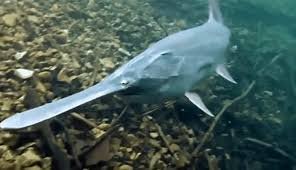
The sword of this fish is more paddle-like, as opposed to the sharp, spiny sword of another swordfish species, the Marlin.

A Chinese paddlefish on display at the Smithsonian.

Tiger-like striped markings


Strong tail
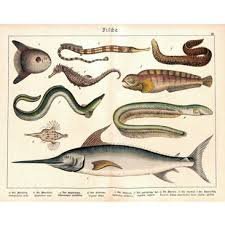
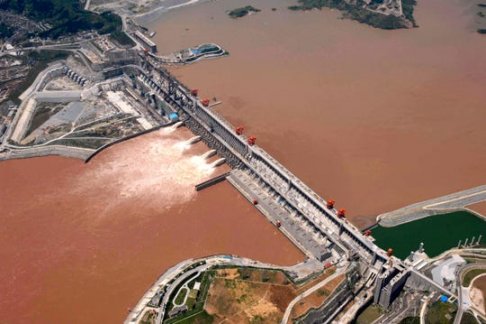
An image of the China Three Gorges Dam. The Gezhouba Dam of the middle reaches was completed in December 1988. It was called the Gezhouba Water Control Project and was mainly constructed for hydroelectric power generation purposes. This kind of thinking takes the short view. The long view is how long the fish species lived, and what a short time it took to accomplish the extermination of a very successful, long-lived fish species.

Chinese swordfish dinner with bok choy


The fauna of a habitat often informs the art and culture of the region
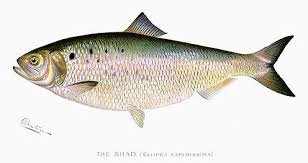
Shad
(Edit: there is mention on the internet that although the Baiji (white Yangtze River dolphins) were declared extinct in 2006, a sighting may have been made in 2016, although this could not be scientifically confirmed, and nothing more has been heard in the last 3 years.)
Only last week, the Chinese Ministry of Agriculture and Rural Affairs, announced a 10-year ban on fishing at 300 conservation areas along the river, Vice Minister Yu Kangzhen told the China Daily. I'm not sure how well that will go, as the human population living in the environs of the river is mind-blowing.
The largest known ever recorded Chinese Paddlefish was 23 feet long, and weighed in at several thousand pounds. These fish were known as the water tiger, or panda of the Yangtze. They were a charismatic megafauna species found in a freshwater ecosystem. The extinction is thought due to habitat fragmentation and overfishing. They travelled in schools near the surface, and were easily netted. The species reproduced later in life (as it took time to grow to their amazing sizes), and this meant a longer time for the species to recover from depletion.
A quick search on search engines reveals that the paddlefish and swordfish meat made very popular dishes, and when eaten with mainly vegetables would have been a high protein, healthy meal. I wonder how many Chinese have subsisted on this food source for many generations back into antiquity?
In 1970, a hydroelectric scheme was planned and commenced to dam the middle reaches of the Yangtze by the construction of the Gezhouba Dam, which had the devastating affect on this fish species, as it was their habit to travel upstream to the upper reaches of the Yangtze to their spawning grounds, and with the dam in place, they were no longer able to do so.
The only living relative of this fish species is the American paddlefish, which is already extinct in Michigan and Canada. This fish was known in the Mississipi River and there are native American stories about it. It looks like American conservation has a big job on its hands to manage what remains of this fish species in the wild.
On a side note, two other species of fauna native to the Yangtze River have also gone extinct - the Reeves Shad (small fish) and the Yangtze River Dolphin (baiji).

The sword of this fish is more paddle-like, as opposed to the sharp, spiny sword of another swordfish species, the Marlin.

A Chinese paddlefish on display at the Smithsonian.

Tiger-like striped markings


Strong tail


An image of the China Three Gorges Dam. The Gezhouba Dam of the middle reaches was completed in December 1988. It was called the Gezhouba Water Control Project and was mainly constructed for hydroelectric power generation purposes. This kind of thinking takes the short view. The long view is how long the fish species lived, and what a short time it took to accomplish the extermination of a very successful, long-lived fish species.

Chinese swordfish dinner with bok choy


The fauna of a habitat often informs the art and culture of the region

Shad
(Edit: there is mention on the internet that although the Baiji (white Yangtze River dolphins) were declared extinct in 2006, a sighting may have been made in 2016, although this could not be scientifically confirmed, and nothing more has been heard in the last 3 years.)
Last edited:







